Even before BBC2 came on the air in 1964 there had been a debate concerning who should own a fourth television channel. ITV wanted it because (as they pointed out) the BBC with the advent of BBC2 had two channels whereas ITV had only the one, though by 1979 ITV’s viewing figures were exceeding the combined BBC1 and 2 figure so this argument started to sound weak (even if many TV sets had their fourth button marked ‘ITV2’ since it seemed logical). Back in 1964 the Conservative Party promised ITV that it would get the fourth channel if they won that year’s election – they didn’t win, so the issue was postponed as other factors took precedence. Work was progressing slowly, though by 1979 it seems that progress towards a fourth channel was at last starting to make some headway.
The 1979 General Election was predicted to be the crucial factor as to what the fourth channel would be like. If the Labour Government was returned to power again, the fourth channel would be run by an organisation known as the OBA (Open Broadcasting Authority). This was a popular choice (as opinion polls showed) since it would be completely different from the established channels’ programming, being community-based and non-profit making. However it was predicted that it would only have (roughly) a 2% audience share, and there were unanswered questions in relation to funding such an enterprise.
That did not happen (of course); the Conservative Party came to power, led by Margaret Thatcher – they were predicted to give the new channel to ITV in order to give them their ITV2. Another alternative discussed at the time was to create an entirely separate new commercial channel (the approach favoured by the advertising agencies – they hoped that the aggressive competition between two openly competing commercial channels that would be the result would drive down advertising rates); but the end result was surprisingly different from those proposals mentioned even if it featured common elements from all three approaches.
 Although initially regulated by the Independent Broadcasting Authority (IBA) with financial cross-subsidy from the ITV franchises, Channel 4 was a broadcaster designed to be independent from ITV, but due to a perceived high risk of financial failure such measures were necessary along with ITV franchises providing some of the programming and being responsible for the channel’s advertising sales, effectively leaving Channel 4 to do what it wanted without having to specifically pander to any of its advertisers. Its remit was and still is essentially similar to BBC2, namely producing specialist programmes for a smaller audience as well as popular programmes, though to begin with Channel 4 was unique in that the majority of programmes were commissioned from small independent production companies.
Although initially regulated by the Independent Broadcasting Authority (IBA) with financial cross-subsidy from the ITV franchises, Channel 4 was a broadcaster designed to be independent from ITV, but due to a perceived high risk of financial failure such measures were necessary along with ITV franchises providing some of the programming and being responsible for the channel’s advertising sales, effectively leaving Channel 4 to do what it wanted without having to specifically pander to any of its advertisers. Its remit was and still is essentially similar to BBC2, namely producing specialist programmes for a smaller audience as well as popular programmes, though to begin with Channel 4 was unique in that the majority of programmes were commissioned from small independent production companies.
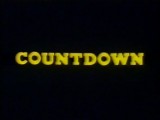 Channel 4 launched with a sequence showing clips from various forthcoming programmes, but the very first programme to be shown on Channel 4 when it finally launched on 2 November 1982 was Countdown. Based on a long-running French TV quiz format entitled Des Chiffres et des Lettres (Numbers and Letters), Countdown started life as an regional (Yorkshire) ITV programme entitled Calendar Countdown earlier in 1982 before being commissioned for Channel 4 by controller Sir Jeremy Issacs.
Channel 4 launched with a sequence showing clips from various forthcoming programmes, but the very first programme to be shown on Channel 4 when it finally launched on 2 November 1982 was Countdown. Based on a long-running French TV quiz format entitled Des Chiffres et des Lettres (Numbers and Letters), Countdown started life as an regional (Yorkshire) ITV programme entitled Calendar Countdown earlier in 1982 before being commissioned for Channel 4 by controller Sir Jeremy Issacs.
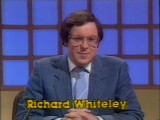 Countdown is a fairly ‘genteel’ quiz based on games that use numbers and letters, and is the only Channel 4 programme apart from Channel 4 News which is still being produced today. The very first presenter to appear on the new channel was none other than Richard Whiteley, who was a familiar face to ITV viewers in the Yorkshire region (Yorkshire TV – now owned by Granada – produces Countdown for Channel 4). Richard became a cult figure nationally as a result of presenting Countdown though he sadly died in June 2005 after an illness.
Countdown is a fairly ‘genteel’ quiz based on games that use numbers and letters, and is the only Channel 4 programme apart from Channel 4 News which is still being produced today. The very first presenter to appear on the new channel was none other than Richard Whiteley, who was a familiar face to ITV viewers in the Yorkshire region (Yorkshire TV – now owned by Granada – produces Countdown for Channel 4). Richard became a cult figure nationally as a result of presenting Countdown though he sadly died in June 2005 after an illness.
 One familiar face that appeared on the very first edition of Countdown was that of Ted Moult, who was known nationally to many people as a gardener and also from his appearances on other TV quiz shows. And one person making her TV debut was Carol Vorderman, who was initially just employed as the ‘resident statistician’ and was presented as a graduate from Cambridge University; she of course was later to take greater responsibility for both the letters and numbers games.
One familiar face that appeared on the very first edition of Countdown was that of Ted Moult, who was known nationally to many people as a gardener and also from his appearances on other TV quiz shows. And one person making her TV debut was Carol Vorderman, who was initially just employed as the ‘resident statistician’ and was presented as a graduate from Cambridge University; she of course was later to take greater responsibility for both the letters and numbers games.
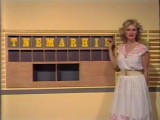 The very first Countdown ‘letters game’ produced this selection of consonants and vowels – T, N, E, M, A, R, H, I, B – of which the two contestants were able to think of two seven-letter words ‘raiment’ (an item of clothing) and ‘minaret’ (a thin tower that’s part of a mosque) respectively. Note the different colour scheme used for the letters board compared with that used today.
The very first Countdown ‘letters game’ produced this selection of consonants and vowels – T, N, E, M, A, R, H, I, B – of which the two contestants were able to think of two seven-letter words ‘raiment’ (an item of clothing) and ‘minaret’ (a thin tower that’s part of a mosque) respectively. Note the different colour scheme used for the letters board compared with that used today.
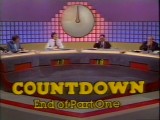 There were other notable differences between Countdown when it first launched and the same show as it appears today; the contestants do not have name labels and there were two guests in ‘dictionary corner’ as well as Carol Vorderman on hand to make sure that everything ran smoothly.
There were other notable differences between Countdown when it first launched and the same show as it appears today; the contestants do not have name labels and there were two guests in ‘dictionary corner’ as well as Carol Vorderman on hand to make sure that everything ran smoothly.
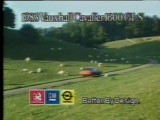 Another difference between Channel 4 and the other channels was that all programmes were shown across England, Scotland and Northern Ireland, but commercials could either be shown nationally or in specific regional areas (based on the ITV regions). The first commercial to be shown on the new channel was for the Vauxhall Cavalier 1600 GLS.
Another difference between Channel 4 and the other channels was that all programmes were shown across England, Scotland and Northern Ireland, but commercials could either be shown nationally or in specific regional areas (based on the ITV regions). The first commercial to be shown on the new channel was for the Vauxhall Cavalier 1600 GLS.
 Channel 4, like BBC2, got off to a shaky start but for different reasons. A disagreement concerning actor’s pay for commercials shown on the fledgling network resulted in an industrial dispute that prevented actors from appearing ‘on camera’ in commercials. This resulted in either a small number of commercials being shown or no commercials at all (depending on the region), at least until the dispute was resolved. Wales has a separate service called S4C with its own Welsh language programming (as well as showing programmes from Channel 4) which had launched the previous day.
Channel 4, like BBC2, got off to a shaky start but for different reasons. A disagreement concerning actor’s pay for commercials shown on the fledgling network resulted in an industrial dispute that prevented actors from appearing ‘on camera’ in commercials. This resulted in either a small number of commercials being shown or no commercials at all (depending on the region), at least until the dispute was resolved. Wales has a separate service called S4C with its own Welsh language programming (as well as showing programmes from Channel 4) which had launched the previous day.
 Channel 4 transmitted programmes in the evenings only to begin with, so Channel 4’s test card was a familiar sight for viewers tuning in during the morning and daytime. Unlike BBC2 a new television set was not mandatory, and the fact that the UK UHF transmitter network had from the outset been designed to offer four channels meant that no new aerial was required. Also unlike previous channel launches most of the transmitters were already set up so most of the population could receive the channel (apart from some remote areas).
Channel 4 transmitted programmes in the evenings only to begin with, so Channel 4’s test card was a familiar sight for viewers tuning in during the morning and daytime. Unlike BBC2 a new television set was not mandatory, and the fact that the UK UHF transmitter network had from the outset been designed to offer four channels meant that no new aerial was required. Also unlike previous channel launches most of the transmitters were already set up so most of the population could receive the channel (apart from some remote areas).
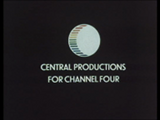 Various ITV franchises made programming contributions to the Channel 4 (and S4C) schedule alongside independent producers, including hard-hitting drama Walter produced by Central Television, Countdown produced by Yorkshire Television, 4 What Its Worth produced by Thames Television, amongst numerous others.
Various ITV franchises made programming contributions to the Channel 4 (and S4C) schedule alongside independent producers, including hard-hitting drama Walter produced by Central Television, Countdown produced by Yorkshire Television, 4 What Its Worth produced by Thames Television, amongst numerous others.
 The new channel tried out some brave programming ideas in its early years. The Friday Alternative was a hard-hitting politically controversial current affairs show with some key differences; no presenters were visible, there was a left-of-centre political bias and it made heavy use of computer animation between video footage. Indeed The Friday Alternative proved to be so controversial it triggered a row between Channel 4 News producer ITN and Channel 4, forcing the channel into commissioning Diverse Reports as a replacement instead.
The new channel tried out some brave programming ideas in its early years. The Friday Alternative was a hard-hitting politically controversial current affairs show with some key differences; no presenters were visible, there was a left-of-centre political bias and it made heavy use of computer animation between video footage. Indeed The Friday Alternative proved to be so controversial it triggered a row between Channel 4 News producer ITN and Channel 4, forcing the channel into commissioning Diverse Reports as a replacement instead.
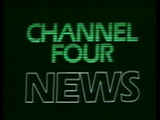 Channel 4 News, the 50 minute-long peak time news bulletin along with (perhaps amazingly) Countdown are the only two survivors of Channel 4’s original schedule that continue to be shown to this day. Early critics of the channel dubbed it “Channel Bore” or “Channel Snore”, though it’s naturally easy to knock something if it’s trying to be different.
Channel 4 News, the 50 minute-long peak time news bulletin along with (perhaps amazingly) Countdown are the only two survivors of Channel 4’s original schedule that continue to be shown to this day. Early critics of the channel dubbed it “Channel Bore” or “Channel Snore”, though it’s naturally easy to knock something if it’s trying to be different.
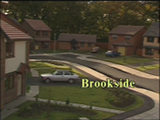 As well as all the arty experimental programming there were much more down to earth offerings like the soap opera Brookside produced by independent production company Mersey Television. Brookside used its own private housing estate as a set, which was unusual for a drama series at that time as opposed to the more normal practice of using a constructed set in a large television studio which gets dismantled and stored away when not in use, but for continuing drama like Brookside, Coronation Street or EastEnders, a permanent set makes a lot more sense. When Brookside came to an end in 2006, the Brookside Close properties were renovated and sold off as private properties, enabling anyone with enough money to actually live in a piece of televisual history.
As well as all the arty experimental programming there were much more down to earth offerings like the soap opera Brookside produced by independent production company Mersey Television. Brookside used its own private housing estate as a set, which was unusual for a drama series at that time as opposed to the more normal practice of using a constructed set in a large television studio which gets dismantled and stored away when not in use, but for continuing drama like Brookside, Coronation Street or EastEnders, a permanent set makes a lot more sense. When Brookside came to an end in 2006, the Brookside Close properties were renovated and sold off as private properties, enabling anyone with enough money to actually live in a piece of televisual history.
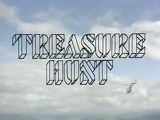 Another very popular programme shown during the first few years of the channel’s life was Treasure Hunt, a quiz show presented by Kenneth Kendall that featured two contestants in a TV studio with a library of reference books to help them find and solve clues that could be found within a particular geographical area and within a 45 minute timescale that ultimately led to a cash prize if they were successful.
Another very popular programme shown during the first few years of the channel’s life was Treasure Hunt, a quiz show presented by Kenneth Kendall that featured two contestants in a TV studio with a library of reference books to help them find and solve clues that could be found within a particular geographical area and within a 45 minute timescale that ultimately led to a cash prize if they were successful.
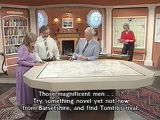 Each Treasure Hunt clue consisted of a card with a printed riddle that gave cryptic details of a location where the next clue could be found; the first clue was read out in the studio at the start of the game and the contestants then had 45 minutes to find the remaining clues that were usually positioned miles apart from each other in different locations, meaning that the contestants had to solve each clue using reference books in the studio and then give verbal instructions to a ‘skyrunner’ (Anneka Rice, later Annabel Croft) via an audio link without any form of visual assistance between the two in order to direct the skyrunner to the location where the next clue is hopefully located.
Each Treasure Hunt clue consisted of a card with a printed riddle that gave cryptic details of a location where the next clue could be found; the first clue was read out in the studio at the start of the game and the contestants then had 45 minutes to find the remaining clues that were usually positioned miles apart from each other in different locations, meaning that the contestants had to solve each clue using reference books in the studio and then give verbal instructions to a ‘skyrunner’ (Anneka Rice, later Annabel Croft) via an audio link without any form of visual assistance between the two in order to direct the skyrunner to the location where the next clue is hopefully located.
 Treasure Hunt’s skyrunner had the use of a helicopter to quickly travel to various locations, though inevitably she usually had to do some running and/or borrow other forms of transport in order to actually get to the clue in question from the helicopter landing site. A map on the studio wall showed the approximate location of the helicopter at any given point, and the remaining time in minutes:seconds was often displayed on the screen, with the clock stopping for a while as soon as each clue was found. All the clues had to be solved before the clock reached zero, though there was an additional clue located nearby for a bonus prize if there was still sufficient time remaining (something that almost never happened).
Treasure Hunt’s skyrunner had the use of a helicopter to quickly travel to various locations, though inevitably she usually had to do some running and/or borrow other forms of transport in order to actually get to the clue in question from the helicopter landing site. A map on the studio wall showed the approximate location of the helicopter at any given point, and the remaining time in minutes:seconds was often displayed on the screen, with the clock stopping for a while as soon as each clue was found. All the clues had to be solved before the clock reached zero, though there was an additional clue located nearby for a bonus prize if there was still sufficient time remaining (something that almost never happened).
 This style of promotion was used by Channel 4 during 1984, featuring an Orwellian “Big Brother”-style stone slab with added ‘4’ logo which appeared at the end. A wide variety of imaginative programming appeared on the channel during 1984, including Let’s Parlez Franglais (an adaptation of Miles Kington’s magazine feature), Night Beat News (a newsroom comedy also produced in a Welsh language version), and a television opera entitled Perfect Lives. Daytime programming also commenced in 1984 with Channel 4 Racing.
This style of promotion was used by Channel 4 during 1984, featuring an Orwellian “Big Brother”-style stone slab with added ‘4’ logo which appeared at the end. A wide variety of imaginative programming appeared on the channel during 1984, including Let’s Parlez Franglais (an adaptation of Miles Kington’s magazine feature), Night Beat News (a newsroom comedy also produced in a Welsh language version), and a television opera entitled Perfect Lives. Daytime programming also commenced in 1984 with Channel 4 Racing.
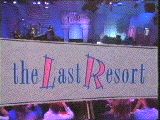 By the mid 1980s programmes such as The Word and The Last Resort gained notoriety and media coverage, making Mark Lamarr and the sharp-suited Jonathan Ross stars (among other people). What started life as Friday Live grew into Saturday Night Live was instrumental in changing the whole face of British comedy, launching a whole selection of ‘alternative’ comedians such as Ben Elton (who presented the show), Harry Enfield and Jo Brand. Channel 4 has also commissioned films such as My Beautiful Launderette, Four Weddings and a Funeral, and Slumdog Millionaire. The ‘youth’ show Network Seven was hugely influential in relation to programme production trends, even though the show itself had only a very small audience.
By the mid 1980s programmes such as The Word and The Last Resort gained notoriety and media coverage, making Mark Lamarr and the sharp-suited Jonathan Ross stars (among other people). What started life as Friday Live grew into Saturday Night Live was instrumental in changing the whole face of British comedy, launching a whole selection of ‘alternative’ comedians such as Ben Elton (who presented the show), Harry Enfield and Jo Brand. Channel 4 has also commissioned films such as My Beautiful Launderette, Four Weddings and a Funeral, and Slumdog Millionaire. The ‘youth’ show Network Seven was hugely influential in relation to programme production trends, even though the show itself had only a very small audience.
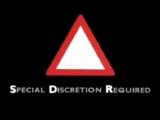 Channel 4 has never been afraid to be controversial. In 1987 the channel decided to experiment with using what was known as the ‘red triangle’; the idea being was that the triangle would be displayed in the top left hand corner of the screen throughout programmes that featured scenes containing violence or explicit sexual content, effectively serving as a content warning. Opponents to this idea said that this would be an excuse to show even more sex and violence, and viewing figures for programmes that featured the red triangle conversely went up. Within months the whole experiment was quietly dropped.
Channel 4 has never been afraid to be controversial. In 1987 the channel decided to experiment with using what was known as the ‘red triangle’; the idea being was that the triangle would be displayed in the top left hand corner of the screen throughout programmes that featured scenes containing violence or explicit sexual content, effectively serving as a content warning. Opponents to this idea said that this would be an excuse to show even more sex and violence, and viewing figures for programmes that featured the red triangle conversely went up. Within months the whole experiment was quietly dropped.
 The Open College was a short-lived attempt to replicate the higher education success of the Open University on Channel 4, and to this end there was an agreement between the Open College – a new educational entity independent of Channel 4 that was created by the government of the day – and Channel 4 to transmit educational programmes from 1988 onwards with Channel 4 providing assistance in terms of resources and time to the approximate value of £1m per year. Open College programmes included Make It Count presented by Fred Harris, but unlike its Open University counterpart, Open College proved to be a failure and the project was soon abandoned.
The Open College was a short-lived attempt to replicate the higher education success of the Open University on Channel 4, and to this end there was an agreement between the Open College – a new educational entity independent of Channel 4 that was created by the government of the day – and Channel 4 to transmit educational programmes from 1988 onwards with Channel 4 providing assistance in terms of resources and time to the approximate value of £1m per year. Open College programmes included Make It Count presented by Fred Harris, but unlike its Open University counterpart, Open College proved to be a failure and the project was soon abandoned.
 During the Christmas period in 1990 Channel 4 used this ‘psychedelic four’ with flashing colours as a special ident. As well as being controversial, Channel 4 produces the usual quizzes, soap operas, current affairs, etc., that can be found on other mainstream channels therefore catering for a very wide cross section of the population as a result.
During the Christmas period in 1990 Channel 4 used this ‘psychedelic four’ with flashing colours as a special ident. As well as being controversial, Channel 4 produces the usual quizzes, soap operas, current affairs, etc., that can be found on other mainstream channels therefore catering for a very wide cross section of the population as a result.
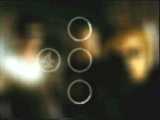 In the 1990s Channel 4 started a continuous 24-hour service, and then in 1997 controversially ditched its original ‘coloured 4’ in favour of using a white ‘4’ symbol in conjunction with either circles or squares, as shown here. This was also one of the first examples of the use of real people as part of idents as opposed to showing just a symbol or static drawing of some description; an idea which was to be later copied by many other broadcasters.
In the 1990s Channel 4 started a continuous 24-hour service, and then in 1997 controversially ditched its original ‘coloured 4’ in favour of using a white ‘4’ symbol in conjunction with either circles or squares, as shown here. This was also one of the first examples of the use of real people as part of idents as opposed to showing just a symbol or static drawing of some description; an idea which was to be later copied by many other broadcasters.
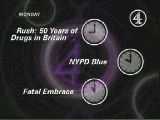 The change did not meet universal acclaim – indeed Channel 4’s image was soon to change again much sooner than expected (see below) due to a perceived unpopularity of its new circles-based identity. On January 1 1999 Channel 4 stopped promoting ITV programmes (and vice versa) as the ties between ITV and Channel 4 were finally cut – Channel 4 was now effectively an independent broadcaster.
The change did not meet universal acclaim – indeed Channel 4’s image was soon to change again much sooner than expected (see below) due to a perceived unpopularity of its new circles-based identity. On January 1 1999 Channel 4 stopped promoting ITV programmes (and vice versa) as the ties between ITV and Channel 4 were finally cut – Channel 4 was now effectively an independent broadcaster.
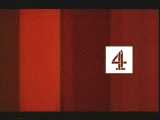 Out with the old, in with the new – Channel 4 introduced its second image ‘makeover’ on 2 April 1999. The unloved circles were ditched in favour of a simple square-shaped logo in combination with scrolling bands of colour; at the same time Channel 4 controversially also tried using a DOG (digitally originated graphic) on its digital feed, meaning that ONdigital and SkyDigital viewers of the channel are treated to a permanent on-screen symbol similar to that used by Channel 5 at the time. This however was later removed because of complaints from viewers, though Channel 4 HD has an on-screen logo presumably to help promote/distinguish the high definition service from its standard definition channel.
Out with the old, in with the new – Channel 4 introduced its second image ‘makeover’ on 2 April 1999. The unloved circles were ditched in favour of a simple square-shaped logo in combination with scrolling bands of colour; at the same time Channel 4 controversially also tried using a DOG (digitally originated graphic) on its digital feed, meaning that ONdigital and SkyDigital viewers of the channel are treated to a permanent on-screen symbol similar to that used by Channel 5 at the time. This however was later removed because of complaints from viewers, though Channel 4 HD has an on-screen logo presumably to help promote/distinguish the high definition service from its standard definition channel.
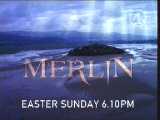 Compare and contrast: this picture was taken from the end of a programme trailer that was shown just before the April 1999 changes were introduced to the channel. The old-style ‘4 in a circle’ is just visible in the top right hand corner of the picture.
Compare and contrast: this picture was taken from the end of a programme trailer that was shown just before the April 1999 changes were introduced to the channel. The old-style ‘4 in a circle’ is just visible in the top right hand corner of the picture.
 And this picture was taken from the end of the revised style of trailer for exactly the same programme. Note that the screen is now essentially divided into two areas, with the larger left area being free for the display of programme information whilst maintaining the logo on the right side of the screen.
And this picture was taken from the end of the revised style of trailer for exactly the same programme. Note that the screen is now essentially divided into two areas, with the larger left area being free for the display of programme information whilst maintaining the logo on the right side of the screen.
 Since the ‘square’ look was introduced, subtle changes were subsequently made; at one point the ‘4’ square occasionally flipped across the screen into position, though in other respects the presentation had changed relatively little apart from the introduction of ‘split screens’ at the end of programmes along with ‘now and next’ menus. (Sometimes background images were used behind the moving lines for idents as in this example.) In July 2000, Channel 4 introduced a brand new reality TV show based in a house containing people who are continually watched by cameras and aren’t allowed to leave until they are evicted, namely Big Brother.
Since the ‘square’ look was introduced, subtle changes were subsequently made; at one point the ‘4’ square occasionally flipped across the screen into position, though in other respects the presentation had changed relatively little apart from the introduction of ‘split screens’ at the end of programmes along with ‘now and next’ menus. (Sometimes background images were used behind the moving lines for idents as in this example.) In July 2000, Channel 4 introduced a brand new reality TV show based in a house containing people who are continually watched by cameras and aren’t allowed to leave until they are evicted, namely Big Brother.
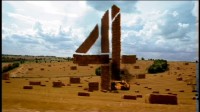 The last day of 2004 saw the launch of Channel 4’s new ident package, which essentially saw the return of the Channel 4 logo building up in three dimensions, except this time the logo is formed using building blocks comprising of abstract pieces of landscape such as hedges, concrete blocks, road signs or bales of hay for a surreal effect as the sequence progresses.
The last day of 2004 saw the launch of Channel 4’s new ident package, which essentially saw the return of the Channel 4 logo building up in three dimensions, except this time the logo is formed using building blocks comprising of abstract pieces of landscape such as hedges, concrete blocks, road signs or bales of hay for a surreal effect as the sequence progresses.
 Other changes were introduced at the same time including a new look for Channel 4 News (essentially swapping its black and purple colour scheme for new titles and studio appearance in white and blue colours) as well as two new styles of programme promotion, though some minor tweaks were made to Channel 4’s presentation soon after launch. Also note that Channel 4 News was one of the last regularly-broadcast programmes shown on one the main five channels to switch over to widescreen broadcasting as opposed to using the older 4:3 standard, presumably due to cost reasons and/or various other news sources still providing video in the 4:3 aspect ratio at the time.
Other changes were introduced at the same time including a new look for Channel 4 News (essentially swapping its black and purple colour scheme for new titles and studio appearance in white and blue colours) as well as two new styles of programme promotion, though some minor tweaks were made to Channel 4’s presentation soon after launch. Also note that Channel 4 News was one of the last regularly-broadcast programmes shown on one the main five channels to switch over to widescreen broadcasting as opposed to using the older 4:3 standard, presumably due to cost reasons and/or various other news sources still providing video in the 4:3 aspect ratio at the time.
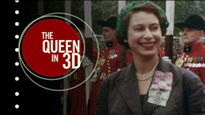 For a week in 2010, Channel 4 jumped on an emerging but short-lived bandwagon for 3D television with a special week of programmes featuring old 3D film footage taken of The Queen and various other people, places and objects. The experiment was essentially similar to the 3D experiments previously conducted by ITV franchise TVS in 1982 which required viewers to wear cardboard glasses with specially-tinted cellophane lenses that were given away with each copy of the TV Times, except that the colour tints used in the Channel 4 experiment were different therefore you couldn’t reuse the same glasses, so you most likely had to obtain new glasses that were made available from branches of Sainsbury’s supermarkets (and a few other places) in order to watch those broadcasts.
For a week in 2010, Channel 4 jumped on an emerging but short-lived bandwagon for 3D television with a special week of programmes featuring old 3D film footage taken of The Queen and various other people, places and objects. The experiment was essentially similar to the 3D experiments previously conducted by ITV franchise TVS in 1982 which required viewers to wear cardboard glasses with specially-tinted cellophane lenses that were given away with each copy of the TV Times, except that the colour tints used in the Channel 4 experiment were different therefore you couldn’t reuse the same glasses, so you most likely had to obtain new glasses that were made available from branches of Sainsbury’s supermarkets (and a few other places) in order to watch those broadcasts.
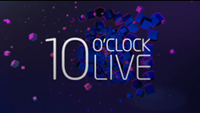 Ever since Channel 4 decided to get rid of Big Brother from its schedule in 2009 (last broadcast in 2010 on Channel 4), there has been a dilemma of exactly what programming to replace it with, especially as Big Brother and Celebrity Big Brother occupied so much of the schedule. A new weekly series looking back at the week’s events from a comic perspective – 10 O’Clock Live – was introduced in 2012, with other comedy offerings such as Stand Up for the Week and panel game 8 out of 10 Cats forming part of the schedule. The controversial Big Fat Gypsy Weddings reality series and its spinoffs generated lots of publicity but not all of it was positive, therefore those have somewhat inevitably been cancelled as well; other reality shows include One Born Every Minute, The Secret Millionaire, and the controversially-titled The Undateables, as well as educational series like Embarrassing Bodies and How Britain Worked. However Channel 4 has thankfully commissioned a selection of high quality drama series that have partially helped to restore it former reputation for quality programming, namely series like Black Mirror which somewhat distorts reality to make a satirical point, Complicit and the US import Homeland.
Ever since Channel 4 decided to get rid of Big Brother from its schedule in 2009 (last broadcast in 2010 on Channel 4), there has been a dilemma of exactly what programming to replace it with, especially as Big Brother and Celebrity Big Brother occupied so much of the schedule. A new weekly series looking back at the week’s events from a comic perspective – 10 O’Clock Live – was introduced in 2012, with other comedy offerings such as Stand Up for the Week and panel game 8 out of 10 Cats forming part of the schedule. The controversial Big Fat Gypsy Weddings reality series and its spinoffs generated lots of publicity but not all of it was positive, therefore those have somewhat inevitably been cancelled as well; other reality shows include One Born Every Minute, The Secret Millionaire, and the controversially-titled The Undateables, as well as educational series like Embarrassing Bodies and How Britain Worked. However Channel 4 has thankfully commissioned a selection of high quality drama series that have partially helped to restore it former reputation for quality programming, namely series like Black Mirror which somewhat distorts reality to make a satirical point, Complicit and the US import Homeland.

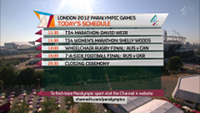
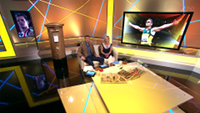
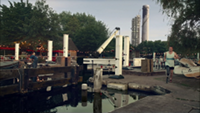 Following on from the hugely successful London 2012 Olympic Games would be a daunting task for anyone, but a combination of goodwill and the promotional skills of Channel 4 turned the following Paralympic Games into a huge success likewise, no doubt helping to make stadium events a sell-out (for the first time in Paralympic history) and generally raising the profile of various sports and competitors. A late evening programme shown during the Games entitled The Last Leg, presented by comedian Adam Hills alongside television newcomers Alex Brooker and Josh Widdecombe who discussed the Games and interviewed Paralympic athletes, became so successful on its own merits it was recommissioned after the Games as a comedy review of the week with celebrity guests. March 2013 saw the introduction of Gogglebox; a series showing families watching and talking about various television programmes in their own homes, which proved to be popular therefore inevitably spawned variants such as Gogglesprogs (featuring children) in 2015 and a one-off ‘Brexit Special’ in 2016.
Following on from the hugely successful London 2012 Olympic Games would be a daunting task for anyone, but a combination of goodwill and the promotional skills of Channel 4 turned the following Paralympic Games into a huge success likewise, no doubt helping to make stadium events a sell-out (for the first time in Paralympic history) and generally raising the profile of various sports and competitors. A late evening programme shown during the Games entitled The Last Leg, presented by comedian Adam Hills alongside television newcomers Alex Brooker and Josh Widdecombe who discussed the Games and interviewed Paralympic athletes, became so successful on its own merits it was recommissioned after the Games as a comedy review of the week with celebrity guests. March 2013 saw the introduction of Gogglebox; a series showing families watching and talking about various television programmes in their own homes, which proved to be popular therefore inevitably spawned variants such as Gogglesprogs (featuring children) in 2015 and a one-off ‘Brexit Special’ in 2016.
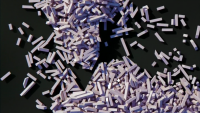 In September 2015 Channel 4 introduced a new and highly abstract on-screen identity featuring the blocks that make up its logo appearing in different forms, using short computer-generated animated sequences; four of these created ident sequences (one shown before each programme) formed an entirely fictional ‘story’. Pictured here is an abstract ‘clock’ animation which immediately preceded the Channel 4 News at 7pm; the hidden clock hands ‘twitched’ but didn’t actually rotate though the blocks themselves did move clockwise once each second. Channel 4’s logo only occasionally appeared in its complete form at certain points between programmes.
In September 2015 Channel 4 introduced a new and highly abstract on-screen identity featuring the blocks that make up its logo appearing in different forms, using short computer-generated animated sequences; four of these created ident sequences (one shown before each programme) formed an entirely fictional ‘story’. Pictured here is an abstract ‘clock’ animation which immediately preceded the Channel 4 News at 7pm; the hidden clock hands ‘twitched’ but didn’t actually rotate though the blocks themselves did move clockwise once each second. Channel 4’s logo only occasionally appeared in its complete form at certain points between programmes.
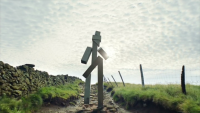 By 2017 Channel 4 introduced fresh computer-generated idents that are more ‘conventional’ in nature, replacing the previous four animated story sequences but keeping most of the rest of the channel’s presentation package as introduced in 2015. They all feature a cartoon figure made out of blocks that does various things, this time accompanied by an acoustic guitar version of the Fourscore theme as originally used back in 1982. 2017 also saw the introduction of The Great British Bake-Off to Channel 4; a baking competition series made by Love Productions but originally commissioned and shown by the BBC. However Channel 4 won the rights to The Great British Bake-Off after a furious bidding war triggered when Love Productions decided that it may be better off moving the popular format to a rival broadcaster.
By 2017 Channel 4 introduced fresh computer-generated idents that are more ‘conventional’ in nature, replacing the previous four animated story sequences but keeping most of the rest of the channel’s presentation package as introduced in 2015. They all feature a cartoon figure made out of blocks that does various things, this time accompanied by an acoustic guitar version of the Fourscore theme as originally used back in 1982. 2017 also saw the introduction of The Great British Bake-Off to Channel 4; a baking competition series made by Love Productions but originally commissioned and shown by the BBC. However Channel 4 won the rights to The Great British Bake-Off after a furious bidding war triggered when Love Productions decided that it may be better off moving the popular format to a rival broadcaster.